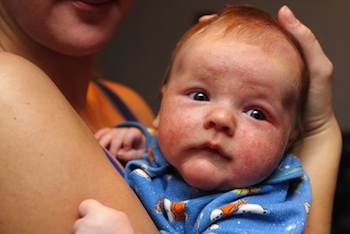- MENU
- HOME
- SEARCH
- WORLD
- MAIN
- AFRICA
- ASIA
- BALKANS
- EUROPE
- LATIN AMERICA
- MIDDLE EAST
- United Kingdom
- United States
- Argentina
- Australia
- Austria
- Benelux
- Brazil
- Canada
- China
- France
- Germany
- Greece
- Hungary
- India
- Indonesia
- Ireland
- Israel
- Italy
- Japan
- Korea
- Mexico
- New Zealand
- Pakistan
- Philippines
- Poland
- Russia
- South Africa
- Spain
- Taiwan
- Turkey
- USA
- BUSINESS
- WEALTH
- STOCKS
- TECH
- HEALTH
- LIFESTYLE
- ENTERTAINMENT
- SPORTS
- RSS
- iHaveNet.com
Sue Hubbard, M.D.

The newest theory is that children with eczema have a defective skin barrier, which allows irritants through resulting in inflammation
A dermatologist friend has been educating me about new research on atopic dermatitis (eczema).
The newest theory is that children with eczema have extrinsically different skin, in that they have a defective skin barrier, which allows irritants into the skin resulting in inflammation. These children seem to have a defect in the filaggrin, a protein in the skin that's important in maintaining skin hydration. There seems to be a mutation in the gene that makes this protein.
Eczema
Think of the top layer of the skin (barrier layer) as a "bricks and mortar" structure, my friend explained. Filaggrin is an important protein in maintaining the normal "mortar" between the cells. If you have defective "mortar" (filaggrin), this is a major risk factor for development of atopic dermatitis. With the loss of the "mortar," there is increased water loss in the skin.
There are also lipids called ceramides in the skin that play an important role in skin hydration because they help bind water. Ceramides make up about 50 percent of the total lipids in the skin. The lipid layer is also important in the "mortar" between the skin cells. Patients with eczema may also have a defect in ceramide production that allows irritants to get into the skin and begin the inflammatory process that we see in eczema patients.
So, what does all of this mean? Several products which are physiologic moisturizers actually contain ceramides, and may repair the skin barrier. These include CeraVe and Aveeno Advanced Care, as well as Epiceram (which is a prescription). There are also other topical therapies, including Atopiclair and Mimyx that act as barrier creams but don't contain ceramides.
Lastly, she discussed the use of bleach baths to decrease staph aureus (bacterial) colonization of the skin, which seems to also help decrease the inflammatory process of eczema. Staph elicits an immune response, which may contribute to dermatitis. It also may induce steroid resistance, in other words, the topical steroids typically prescribed for eczema may not work as well when staph is around.
Staph acts as a "superantigen" and is a trigger for atopic dermatitis. By using bleach baths with 1/8 cup bleach in a half-foot of bath water and soaking your child for 5 or 10 minutes twice a week, you can reduce the skin staph colonization. This may then reduce infection, inflammation and the need for antibiotics.
You can also make a dilute bleach solution and put it in a spray bottle to use locally, especially for older kids who aren't into baths. If a child has scratched himself/herself and has cracks and fissures, it's helpful to apply a layer of Vaseline over the area before doing a bleach bath.
This is all new and interesting data coming out in the pediatric dermatology literature that may change some of our treatments of eczema. Get out the bleach, but don't get it on anything else!
Available at Amazon.com:
WORLD | AFRICA | ASIA | EUROPE | LATIN AMERICA | MIDDLE EAST | UNITED STATES | ECONOMICS | EDUCATION | ENVIRONMENT | FOREIGN POLICY | POLITICS
Health - New Research Offers Hope For Eczema Patients